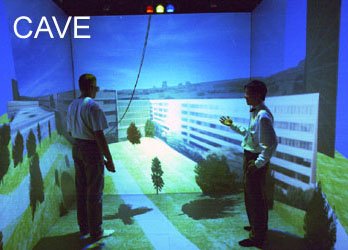Virtual Reality #3 - Hardware options: displays
In this post I'm presenting and comparing the main hardware options in the context of Virtual Reality (VR): the Cave Automatic Virtual Environment (CAVE) and the Head Mounted Display (HMD). These two options greatly differ in their setup, as well as in their application scenarios and target market.
- CAVE: this system consists of a physical room with 4 high-resolution displays: 3 walls and the floor, as shown in the following picture.

Image source
The impression of a virtual 3D environment around the user is achieved with the cooperation of the displays that are placed behind the walls with a pair of shutter glasses that the user is wearing (https://en.wikipedia.org/wiki/Active_shutter_3D_system). The perceived scenario of the user is, therefore, updated as the user moves around. In order to receive updated information of the user's viewpoint, it is necessary to attach a head tracker to the shutter glasses. This personalized display implies that this is a single-user device, since other users would not share the exact same viewpoint.
Due to the required physical setup of this approach and the associated cost, this technology is not aimed at the mass market, but to research labs or corporations.
- HMD: this system consists of an ad-hoc device that the user needs to wear in the head, and is composed of a basic structure, a high-resolution display and a set of sensors (accelerometer, gyroscope and magnetometer). The following figure shows an example of HMD.

Image source
These devices isolate visually the user from the physical environment, and thus enhanhce the sense of presence in the virtual environment. Moreover, it is necessary to consider different factors when selecting an HMD, including weight, comfort and resolution of the display, among others.
It is possible to use our smartphones as VR displays (mobile VR), as long as the technical requirements are met. This is achieved by placing our device in an inexpensive structure, such as the one depicted in the following figure (Google Cardboard), allowing us to reach a wider market.

Image source
However, mobile VR is limited by the built-in sensors of the smartphone and offers less degrees of freedom (https://xinreality.com/wiki/Degrees_of_freedom) in comparison to high-end HMDs.
@originalworks
The @OriginalWorks bot has determined this post by @dbudhrani to be original material and upvoted(1.5%) it!
To call @OriginalWorks, simply reply to any post with @originalworks or !originalworks in your message!